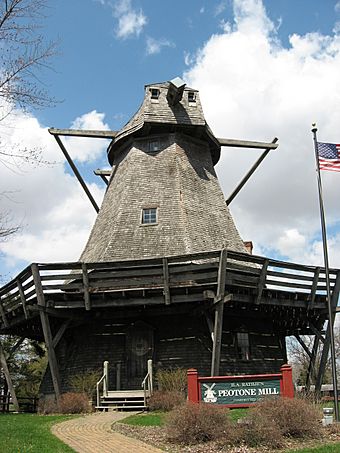Peotone Mill facts for kids
Quick facts for kids |
|
|
Peotone Mill
|
|

The Rathje Mill, or Peotone Mill, is an example of a late 19th-century wind powered grist mill,
|
|
| Location | 433 W. Corning Ave., Peotone, Illinois |
|---|---|
| Area | less than one acre |
| Built | 1872 |
| NRHP reference No. | 82002605 |
| Added to NRHP | March 19, 1982 |
The Peotone Mill, also known as the Rathje Mill, is a historic building. It is located in the village of Peotone, Illinois, in Will County, Illinois, USA. This old mill was given to the Village of Peotone in the early 1980s. It is listed on the National Register of Historic Places. This means it is recognized as an important historical site in the United States. It is also on the Will County Register of Historic Places.
Contents
History of the Peotone Mill
The Peotone Mill was built in 1872. It was originally a windmill. Henry A. Rathje is often given credit for building it. However, his father, Frederick Rathje, and Christoph Elling, actually agreed to build the mill. A document from July 3, 1871, confirms this.
Henry Rathje married Wilhelmina Luhmann in 1874. She was an immigrant from Hanover, Germany. After marrying, Henry Rathje started working in the milling business. He bought the windmill in Peotone and ran it for twelve years. An old invoice from the mill lists Henry Rathje as the owner.
Mill Design and Appearance
The mill was designed by Dutch millwrights. These are people who design and build mills. The mill has a tall tower, about 60 feet high. This made it the tallest building in Peotone at the time. People sometimes called it the town's "skyscraper." The mill has kept its original look for many years. It is a well-known landmark in Peotone and Will County.
How the Peotone Mill Operated
The windmill in Peotone made many different grain products. It produced fine wheat, rye, and buckwheat flours. It also made cornmeal. The mill was very important for local farmers. They depended on it to grind feed for their livestock (farm animals).
Busy Times at the Mill
The busiest time for the mill was in the autumn. This was when farmers would get their grain ground. They needed to stock up on feed for their animals for the winter. The mill stored extra products in a building next to the windmill.
The mill earned money by charging a "toll." This was a small part of the finished product. State laws set the rules for these tolls. In 1885, the mill changed from wind power to steam power. Stories from the Rathje family say the windmill's sails rotted. This is why they switched to steam.
When the Mill Closed
It is not clear exactly when the mill stopped working. People think it might have stopped around 1889. By 1900, the mill was no longer profitable. This was because newer milling methods were being used. Henry Rathje had stopped using it by then. However, the mill continued to operate in some way until World War I. It finally closed completely in 1917.
Preserving the Peotone Mill
For almost 100 years, the Peotone Mill stood empty and quiet. Henry Rathje's son, Paul W. Rathje, did regular maintenance on the mill. Paul W. Rathje had two children, Paul and Helen. The mill was eventually passed down to Paul C. Rathje. He was Henry's grandson.
Paul C. Rathje understood how important the mill was to history. In 1982, he gave it to the Village of Peotone. In the same year, the mill was listed on the National Register of Historic Places.
Restoration Efforts
The Peotone Historical Society decided to restore the mill. Their goal is to make it look and work like it did originally. They have divided the project into different stages. They continue to work on maintaining and restoring the mill. In 2004, the Landmarks Preservation Council of Illinois gave the Peotone Historical Society $5,000. This money was used to check the mill's structure.


